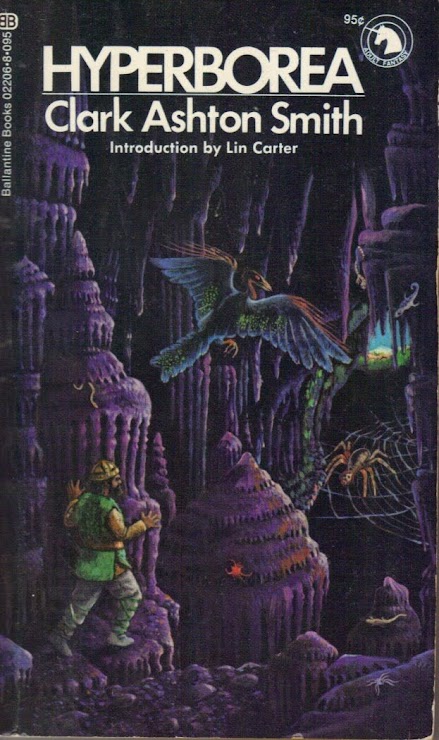So yesterday I was gone most of the day travelling between places and I ran into a friend of mine down in West Hartford at his bookshop. We hadn't seen each other since 2017 at one of the private Cons at a friend's home. There we played in DM Steve's Astonishing Swordsmen & Sorcerer's Hyperborea rpg campaign mini game. Paul runs a small Science Fiction and Fantasy book shop in between botique shops there. What he had for me was a rare copy of the Smith, Clark Ashton (1971). Lin Carter (ed.). Hyperborea. New York: Ballantine Books. ISBN 0-345-02206-8.. The Ballatine edition is excellent for a number of reasons but it really plugs into the Iron age cosmic horror hardcore. And why well the wiki entry on CAS's Hyperborean cycle covers it thus:"The Hyperborean cycle is a series of short stories by Clark Ashton Smith that take place in the fictional prehistoric setting of Hyperborea. Smith's cycle takes cues from his friends, H. P. Lovecraft and Robert E. Howard and their works. Lovecraft wrote to Smith in a letter dated 3 December 1929: "I must not delay in expressing my well-nigh delirious delight at The Tale of Satampra Zeiros [Smith's short story]... [W]hat an atmosphere! I can see & feel & smell the jungle around immemorial Commoriom, which I am sure must lie buried today in glacial ice near Olathoe, in the Land of Lomar!".[1] Soon afterward, Lovecraft included Smith's Tsathoggua (which originally appeared in "The Tale of Satampra Zeiros") in the story "The Mound", ghostwritten for Zealia Bishop in December 1929. Lovecraft also mentioned Tsathoggua in "The Whisperer in Darkness", which he began on February 24, 1930,[2] and in "At the Mountains of Madness" a year later, along with the Hyperborean cities of Commoriom and Uzuldaroum. Because Smith in turn borrowed numerous Lovecraftian elements, the cycle itself may be regarded as a branch of the Cthulhu Mythos. In a letter to August Derleth dated 26 July 1944, Smith wrote: "In common with other weird tales writers, I have ... made a few passing references (often under slightly altered names, such as Iog-Sotot for Yog-Sothoth and Kthulhut for Cthulhu) to some of the Lovecraftian deities. My Hyperborean tales, it seems to me, with their primordial, prehuman and sometimes premundane background and figures, are the closest to the Cthulhu Mythos, but most of them are written in a vein of grotesque humor that differentiates them vastly. However, such a tale as "The Coming of the White Worm" might be regarded as a direct contribution to the Mythos.".[3]"
"The Hyperborean cycle mixes cosmic horror with an Iron Age setting. Adding to the peril is the rapidly approaching ice age, which threatens to wipe out all life on the Hyperborean continent. A host of other deities play important roles in the cycle; foremost is the toad-god Tsathoggua, who dwells in Mount Voormithadreth."
"Hyperborea is a legendary continent in the Arctic. Before it was overwhelmed by the advancing ice sheets of the Pleistocene age, Hyperborea was a warm and fertile paradise, with lush jungles inhabited by the last remnants of the dinosaurs. A race of yeti-like bipeds, known as the Voormi, once populated Hyperborea, but were wiped out by the pre-human settlers who migrated here from the south. These pre-humans built the first capital of Hyperborea, at Commoriom. Later they moved to Uzuldaroum, when prophesies foretold of Commoriom's doom."
Such a frozen continent under the control of the inhuman voormis might require some really interesting back & forth with clerics or headsmen of the god Tsathoggua. There is a ton of potential for adventure in such a frozen wasteland continent. According to the CAS's mythos: " "Hyperborea was supposed to have corresponded roughly with modern Greenland, which had formerly been joined as a peninsula to the main continent" — in Miocene times ("Ubbo-Sathla", Clark Ashton Smith)"
This frozen wasteland could be the homelands of the once proud and decident Hyperborean races of the Hyperborea rpg. Only the ill regarded Voormis may know the answers. But what does this mean to the other ancient Hyperboreans still within their dungeon vaults?
- Coming of the White Worm, The (1941)
- Door to Saturn, The (1932)
- House of Haon-Dor, The (1989)
- Ice-Demon, The (1933)
- Lament for Vixeela (1953)
- Muse of Hyperborea, The (1929)
- Seven Geases, The (1934)
- Tale of Satampra Zeiros, The (1931)
- Testament of Athammaus, The (1932)
- Theft of the Thirty-Nine Girdles, The (1958)
- Ubbo-Sathla (1933)
- Weird of Avoosl Wuthoqquan, The (1932)
- White Sybil, The (1932)

No comments:
Post a Comment
Note: Only a member of this blog may post a comment.